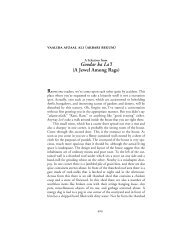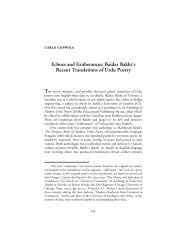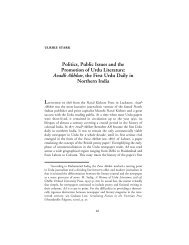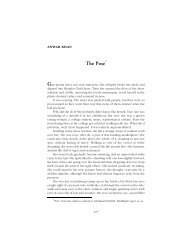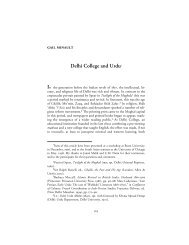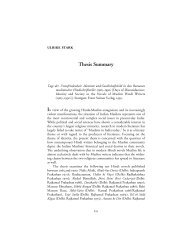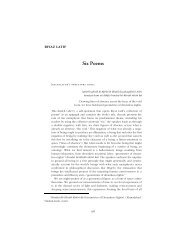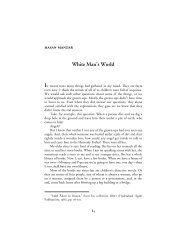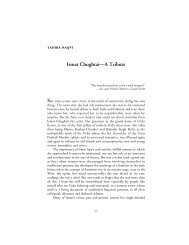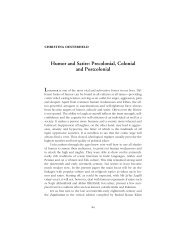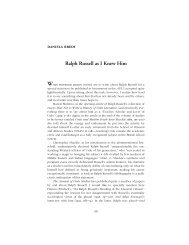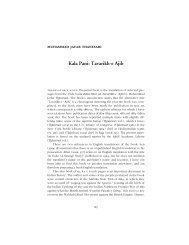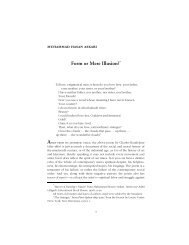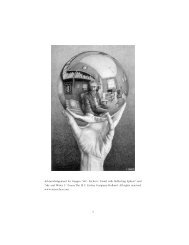Premchand's âShatranj ke Khilariâ in Translation - the Annual of Urdu ...
Premchand's âShatranj ke Khilariâ in Translation - the Annual of Urdu ...
Premchand's âShatranj ke Khilariâ in Translation - the Annual of Urdu ...
You also want an ePaper? Increase the reach of your titles
YUMPU automatically turns print PDFs into web optimized ePapers that Google loves.
Fatima Rizvi • 203<br />
omies <strong>of</strong> magnificence and frivolity that brought about its <strong>in</strong>advertent<br />
downfall. This is unli<strong>ke</strong> <strong>the</strong> H<strong>in</strong>di text which overtly satirizes <strong>the</strong> players<br />
with a condemnation <strong>of</strong> <strong>the</strong>ir bravado.<br />
The open<strong>in</strong>g l<strong>in</strong>es <strong>of</strong> <strong>the</strong> two stories: ìVājid ʿAlī Shāh kā zamāna<br />
tẖāî (Premchand 2011, 104), ìIt was <strong>the</strong> era <strong>of</strong> Wajid Ali Shahî (Premchand<br />
1988, 182), and ìNavāb Vājid ʿAlī Shāh kā zamāna tẖāî (It was <strong>the</strong> era <strong>of</strong><br />
Navāb Vājid ʿAlī Shāh) (Premchand 2010, 83), transport <strong>the</strong> reader <strong>in</strong>to<br />
ano<strong>the</strong>r era. However, by prefix<strong>in</strong>g <strong>the</strong> title ìNavābî to <strong>the</strong> k<strong>in</strong>g <strong>in</strong> <strong>the</strong><br />
<strong>Urdu</strong> text Premchand provides for <strong>the</strong> formality deserv<strong>in</strong>g <strong>of</strong> <strong>the</strong> monarch.<br />
The open<strong>in</strong>g l<strong>in</strong>e <strong>of</strong> <strong>the</strong> <strong>Urdu</strong> text also echoes <strong>the</strong> open<strong>in</strong>g l<strong>in</strong>e, ìĒk tẖā<br />
bādshāh ...î (There was once a k<strong>in</strong>gÖ) <strong>of</strong> <strong>the</strong> oral, ma<strong>ke</strong>-believe narratives<br />
<strong>of</strong> <strong>the</strong> raconteurs <strong>of</strong> Lucknow.<br />
Tara Chandís observation that Sanskritic H<strong>in</strong>di was created on <strong>the</strong><br />
model <strong>of</strong> Persianized <strong>Urdu</strong> (see Faruqi 2001, 55) provides for <strong>the</strong> estimation<br />
that morphologically <strong>the</strong> basic syntax and lexis <strong>of</strong> <strong>Urdu</strong> and H<strong>in</strong>di are<br />
similar, that <strong>the</strong> two share common l<strong>in</strong>guistic doma<strong>in</strong>s. This be<strong>in</strong>g <strong>the</strong><br />
case, Premchandís H<strong>in</strong>di and <strong>Urdu</strong> texts share similar syntactical structures,<br />
but several dist<strong>in</strong>ctions perta<strong>in</strong><strong>in</strong>g to vocabulary are discernible. 3 A morphological<br />
read<strong>in</strong>g <strong>of</strong> <strong>the</strong> texts clearly <strong>in</strong>dicates a paucity <strong>of</strong> vocabulary and<br />
dearth <strong>of</strong> expression <strong>in</strong> <strong>the</strong> H<strong>in</strong>di text; <strong>the</strong> abundant <strong>Urdu</strong> vocabulary and<br />
expression ma<strong>ke</strong> <strong>the</strong> story aes<strong>the</strong>tically more engag<strong>in</strong>g and <strong>the</strong> cultural<br />
representation richer than <strong>the</strong> one <strong>in</strong> H<strong>in</strong>di. This may best be elucidated<br />
by <strong>the</strong> repeated use <strong>of</strong> <strong>the</strong> word vilasita (pleasure/pleasure-seek<strong>in</strong>g) <strong>in</strong> <strong>the</strong><br />
H<strong>in</strong>di text (2011, 104–5) which is exchanged for several compound/portmanteaux<br />
words commonly employed <strong>in</strong> <strong>Urdu</strong> and Persian. For example,<br />
he uses ʿaish-o-ʿishrat (life <strong>of</strong> ease and pleasures), rañg-raliāñ (debauchery),<br />
nafs-parastī (self-gratification), nafs-parvarī (hedonism) (2010, 82–83),<br />
and towards <strong>the</strong> end, <strong>in</strong> reference to <strong>the</strong> two noblemen, ʿaish kē bandē<br />
(men given to sensual pleasures) (ibid., 95) <strong>in</strong> <strong>Urdu</strong> as opposed to vilasi<br />
(2011, 114) <strong>in</strong> H<strong>in</strong>di. In <strong>Urdu</strong> he differentiates <strong>the</strong> pastimes <strong>of</strong> ahl-e saif<br />
(swordsmen) and ahl-e rōzgār (<strong>the</strong> well-employed), whereas <strong>in</strong> <strong>the</strong> H<strong>in</strong>di<br />
text <strong>the</strong> narratorís sardonic enumeration clubs toge<strong>the</strong>r all as vices. The<br />
critical realism <strong>of</strong> <strong>the</strong> modern H<strong>in</strong>di narrator contemptuously reduces <strong>the</strong><br />
era as given over to vilasita. This k<strong>in</strong>d <strong>of</strong> repeated use <strong>of</strong> a s<strong>in</strong>gle word to<br />
substitute for several o<strong>the</strong>rs (carry<strong>in</strong>g similar connotations) <strong>of</strong> ano<strong>the</strong>r<br />
language po<strong>in</strong>ts at <strong>the</strong> serious issue <strong>of</strong> <strong>the</strong> evolution <strong>of</strong> language po<strong>in</strong>ted<br />
out by Dalmia, as regards <strong>the</strong> emergent modern H<strong>in</strong>di, which, ì<strong>in</strong> order to<br />
f<strong>in</strong>d its new feet [...] needed to overhaul its very baseósyntactically, lexi-<br />
3 For a detailed analysis <strong>of</strong> Premchandís language and vocabulary <strong>in</strong> <strong>the</strong> H<strong>in</strong>di<br />
and <strong>Urdu</strong> texts, see Pritchett (1986, 66–72).



